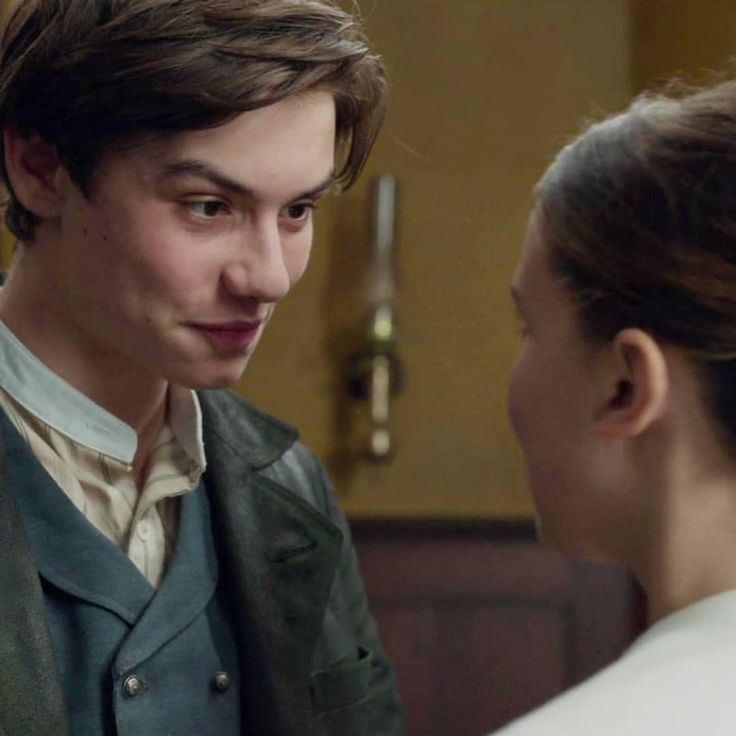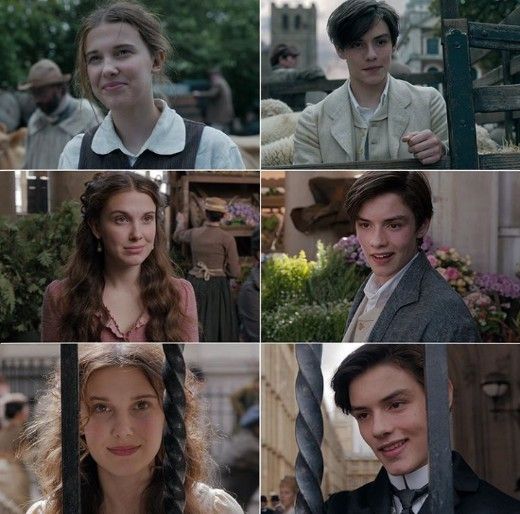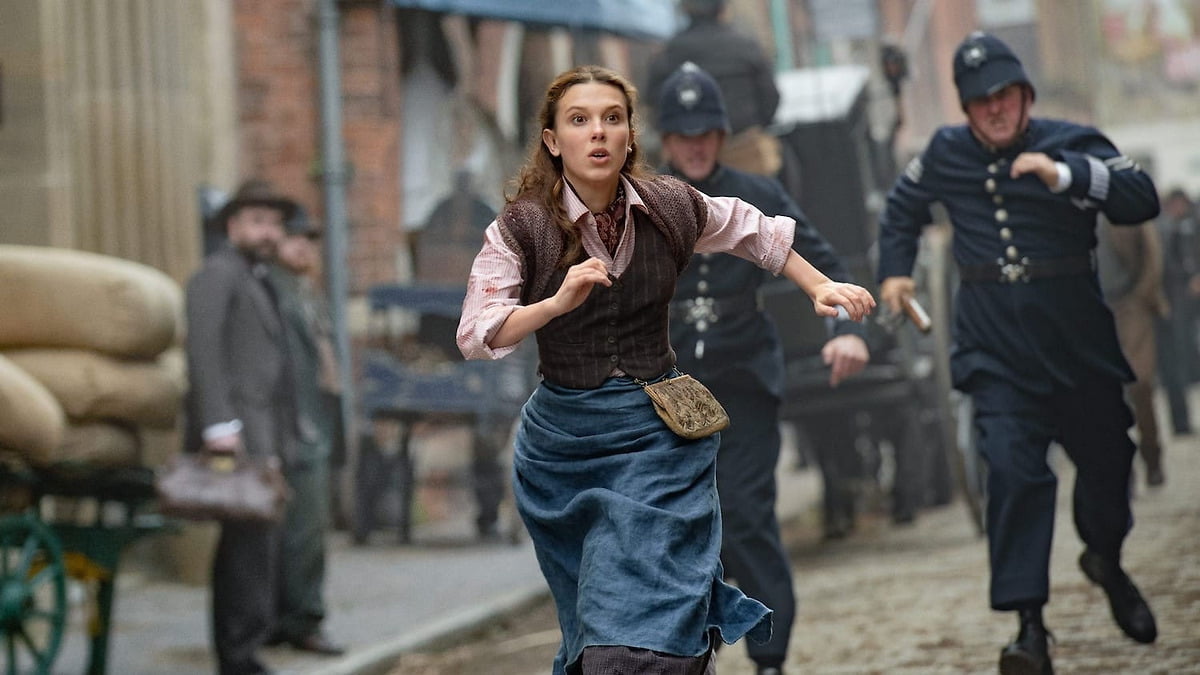Netflix is back with a second part to its hit franchise Enola Holmes and just like the first, Enola Holmes 2 has raked up enough profits worldwide for the streaming company in its very first week to be called a success already. At a first glance, it might be easy to deduce why; Millie Bobby Brown, of Stranger Things fame, reprises her role as Enola Holmes, the quirky, quick-footed, young female sleuth who is also the famous Sherlock Holmes’s sister. The movie, which is once again quite high-budget, is set in Doyle’s Victorian London, a set entangled with a lot of nostalgia for the die-hard Holmes’s fans.
The prison-break scene where Enola is saved by her mother and Edith is riotous and fun and Helena Bonham Carter is, as usual, dazzling and charismatic in capturing the nuances of Eudoria’s strange personality. In fact, flashback scenes to Enola’s peculiar upbringing by her, shows the audience just how influenced Enola has been by her mother and what, at many moments, saves her from falling prey to dangerous situations.
Adapted from American author Nancy Springer’s YA novel-series titled ‘The Enola Holmes Mysteries’, Enola Holmes 2 is a fresh, easy watch for the weekend, a little predictable perhaps, but with all the ingredients that had made the first movie so enjoyable and a few new twists and fan service moments of its own. The star-studded cast, consisting of Henry Cavill as Sherlock Holmes, Helena Bonham Carter as their eccentric and rebellious mother, David Thewlis as the villainous superintendent Grail, and more, is a crowd-puller and everyone does their job well without pulling extra attention to oneself because after all Enola Holmes should not be overshadowed, it is her story and the spotlight should be on her and her adventures. And this is where director Harry Bradbeer and screenplay writer Jack Thorne score a win. They keep it Enola’s story despite nods to Doyle’s universe and the more significant presence and lengthened screen time of Sherlock in this movie.
As the movie starts playing, we find our female detective Enola, a few years after the first movie, setting up a detective agency in her own name, specializing in finding missing persons. Flashback from a chase scene, the audience is immediately introduced to Enola’s struggles as a woman trying to be independent in a conservative Victorian society. This is what the movie does right; notwithstanding the fact that it does not take itself too seriously and is light-hearted with comedic breaks, it never erases the reality of what it means to be a woman in 19th century Victorian era, especially since not much has changed with regards to living in a patriarchal world.

Enola hardly gets clients, and even the ones that come visit her office, all come hopeful in the search of her famous brother, the then established detective Sherlock Holmes. She is asked about her age, her gender in condescending tones and while her brother wins case after case, ruling the front pages of all tabloids, Enola is given no opportunities to make use of her wits or skills. She can’t help but feel overshadowed by her much older powerful brothers, Mycroft and Sherlock, and when she has to close down her agency, her dreams come crashing down even before they have been allowed a chance to bloom. A little girl, called Bessie, comes to report about her sister Sarah Chapman missing and that inaugurates the plot of the movie, or in more iconic words, ‘the game is afoot’. Enola takes the case with renewed enthusiasm, not only because it might be a step in saving her dreams of becoming a famous detective at par with her brother, but also because the little match girl’s worry over her sister’s disappearance tugs at her heartstrings.
The movie therefore showcases strong portrayals of women who play significant roles in the movie and do not subscribe to patriarchal normativity and subjugation.
There is a lot of heart in this movie, majorly owing to the fact perhaps, that certain incidents in the movie are based on very real events and thus evoke strong emotions. As the movie also tells us, in history, “The Match Girls Strike, led by Sarah Chapman was the first ever industrial action taken by women for women; it improved their working conditions forever”. She and other leaders of the movement “have since been recognised as ‘pioneers of gender equality and fairness at work who left a lasting legacy on the trade union movement’”. The story, as much being Enola’s, is also a commentary upon a community of women, living in rigid Victorian society, who stand by each other in times of distress and who refuse to bow down to the expectations of patriarchy and an insidious society that sees them as irreplaceable instead of as human beings deserving of equal rights and dignity.
Also read: Netflix’s ‘Blonde’ Reinforces Marilyn Monroe As A Sex-Symbol Without Deconstructing The Gaze
The movie therefore showcases strong portrayals of women- Enola, the match girls, Enola’s rebellious mother Eudoria, Edith and Mira Troy, all women characters who play significant roles in the movie and do not subscribe to patriarchal normativity and subjugation. The prison-break scene where Enola is saved by her mother and Edith is riotous and fun and Helena Bonham Carter is, as usual, dazzling and charismatic in capturing the nuances of Eudoria’s strange personality. In fact, flashback scenes to Enola’s peculiar upbringing by her shows the audience just how influenced Enola has been by her mother and what, at many moments, saves her from falling prey to dangerous situations. Mira Troy, the wildcard character, utters one of the most poignant dialogues in the movie, which is a simple statement defining the experience of women surviving in a male-dominated world: “Without power, we women must rely on our wits for our fortune, because our chances are short.” Even her ending monologue, as Moriarty, is powerful and thought-provoking.

In the course of the movie, Enola’s case is found to be related to the one Sherlock is solving and the give and take between the brother-sister duo as they bounce off each other’s intellect and stoicism is extremely entertaining to watch and since Henry Cavill’s Sherlock is a much more warmer Sherlock, there are some heart-warming instances between the two.
Also read: Never Have I Ever Season 3: Netflix Show Normalises Women Being Smarter In The Relationship
The only hope is that the future movies do not ruin their momentum by increasing the prominence of Sherlock and opting for token representation as so many movies tend to do nowadays. Now, many might feel the romance between Enola and Tewkesbury to be unnecessary to the plot, but the movie never gets too cheesy and as a YA adaptation does remain faithful to certain common tropes for the audience it is catered towards. Hence, even in the face of tackling some difficult and sensitive issues, Enola Holmes 2 is neither preachy nor didactic. It retains its lightness filled with eureka moments that make detective stories like these so joyful to watch and also takes us back to our familiar world of the sharp-witted Holmes’ and their sinister nemeses.
Movies like these are important, aside from being a breath of fresh air, because the generation that is growing up watching such movies can root for female protagonists on screen while being aware of the problems of gender inequality in the society. This is where Enola Holmes 2, as a YA movie, succeeds.
About the author(s)
Sayeri Biswas recently graduated with a bachelor’s degree in English from St. Xavier’s College, Kolkata. Whether it’s philosophically
contemplating life or gushing about the most recent book/series she has indulged in, she is always up for a deep conversation. Literature is the great love of her life, and in the future, she hopes to continue talking about all art forms as passionately as she thinks
about them.




